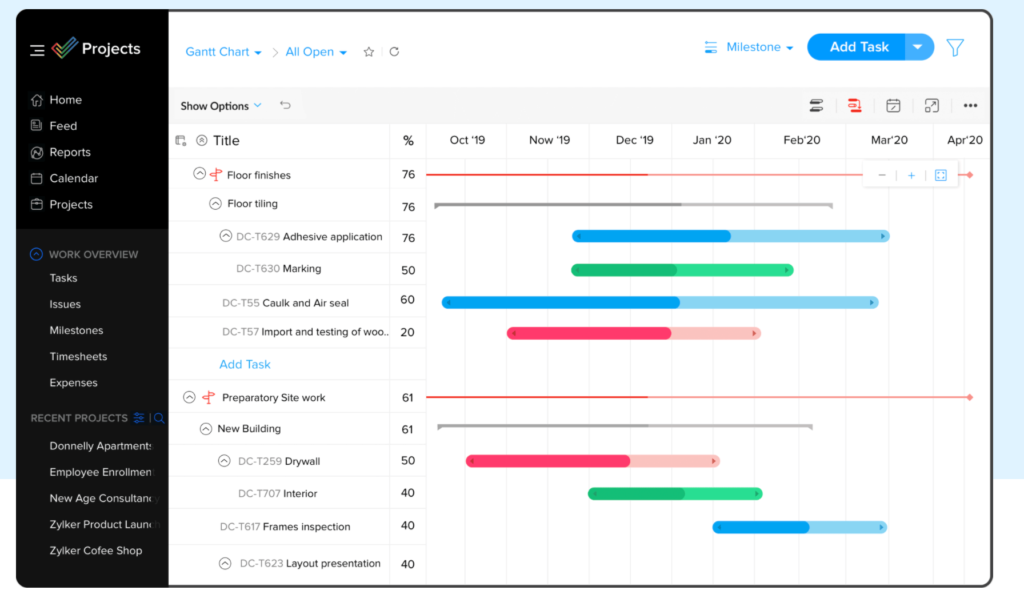“Project management” is a simple term used to describe a complex subject. With so many dimensions to consider, each project must maintain a certain level of rules to ensure its success.
It’s the project manager’s responsibility to understand these principles and apply them to every project that they lead. Regardless of the scope, industry, or project, the management principles remain consistent across the board.
Whether you’re a complete beginner and new to leading teams or you’re an experienced project developer that wants to brush up on the basics, you’ve come to the right place. This guide will dive deep into everything you need to know about project management principles.
What Are Project Management Principles?
Project management principles can be defined as the fundamental rules that must be followed during a project.
The exact principles vary from resource to resource, but they all follow a similar structure and flow. In short, every project involves planning, scheduling, budgeting, organizing, and managing resources to achieve a specific goal. Projects have stakeholders, leaders, and project teams completing tasks from start to finish.
This entire process can be summarized with project management principles.
3 Tools to Improve Project Management Principles
Applying project management principles to a project is much easier if you’re taking advantage of the right resources. Below are three of my favorite tools for project management success.
#1 — Zoho Projects
Zoho Projects is one of the most reputable and reliable project management solutions on the market today. It’s trusted by organizations and teams of all shapes and sizes, including technology leaders like Dell and educational institutions like Stanford University. The software is easy to use, deploy, and manage projects at scale. If you’re managing a remote or distributed team, Zoho Projects keeps everyone organized while maintaining the integrity of your project management principles.
Another reason why I like Zoho Projects is that it’s so versatile. It can be used for software development, marketing projects, construction projects, and so much more. Use it to formalize your work breakdown structure, create a project baseline, and collaborate with your entire team. The software comes with useful templates for projects that can eliminate wasted time in the planning stages. Zoho Projects is free forever for small projects of up to three users. But most teams go with a premium plan, starting at $5 per user per month. Sign up today to start your 10-day free trial of Zoho Projects.
#2 — Wrike
Wrike is another exceptional resource for managing and applying project management principles. It’s one of the most powerful and feature-rich project management tools on the market today and acts as a single source of truth for team collaboration or project planning. Wrike makes it easy for project managers to gain complete visibility and control over every aspect of a project. From delegating tasks to managing workflows and sending reports to stakeholders, Wrike does it all.
Another reason why I like Wrike so much is that it’s highly customizable. It can be used to accommodate the needs of virtually any project type. You can even use it to create custom integrations with 400+ cloud and on-premises business tools. 20,000+ organizations rely on Wrike, including teams within big companies like Airbnb and Google. There’s a free plan for basic use, and paid plans start at just $9.80 per user per month. Sign up today to try Wrike free for 14 days.
#3 — Trello

For a simple way to manage your projects, try Trello. As someone who uses this software on a daily basis, I can personally stand behind its robust functionality for project management. What I like most about this tool compared to other solutions on the market today is its simplicity. It’s a great option for new project managers who are using PM software for the first time. I also recommend Trello if your team is new to project management, as there is virtually no learning curve for this tool.
But don’t let Trello’s simplicity fool you. There is still plenty that can be accomplished using this project management solution. That’s why more than one million companies across the world rely on Trello, including big names like Google, Costco, and Squarespace. From collaborative work to managing workflows, automation, and integrations, Trello has it all. The software is free for individuals and small teams. Paid plans start at $10 per user per month. Try it for free with a 14-day trial.
The Basics of Project Management Principles
No matter what type of project you’re running, the following principles should remain constant for all of them. From software development to construction, product development, and everything else, these are the core elements of project management.
Formal Project Structure
Every project must have a formal structure. This includes the process, procedure, and tools used to complete tasks and manage deliverables along the way.
Managing a project without formalizing your process is a recipe for disaster. That’s why so many project managers typically use project management software to add structure to projects.
Everyone must know the reason why the project exists. While this might seem obvious, it’s important to immediately identify as the structure might change based on the project. Determine what project management methodology will be used, and set up a timeline with milestones to mark the most significant stages of the project.
Project Manager Principles
Every project must have a single leader, known as the project manager. The project manager’s job is to create a plan for the entire project, from start to finish.
The manager will also assemble a team, determine the management framework, and explain to everyone the process for which tasks will get completed.
Project managers are the glue of the project. In addition to the planning and team management, they also handle resource allocation, risk management, budget management, and all communication with project stakeholders.
This position typically falls on a person with leadership skills, management experience, technical knowledge, and more. Even business analysis is a crucial component of effective project management.
Stakeholders and Sponsors
There has to be someone, whether it be an individual, a group, or an organization, behind the project. Whoever determined that a project needs to happen in the first place would be considered a stakeholder or a sponsor.
These individuals have a vested interest in the project and pay for the resources required to achieve a goal.
Stakeholders can be internal or external. For example, let’s say a company decides to create a mobile app. They could use an internal team of developers to handle this project. Or they could outsource the work to an external development agency.
Stakeholders and sponsors communicate directly with the project manager but typically don’t get involved with the day-to-day tasks for project completion. They focus on the big picture and the budget and expect updates on progress along the way.
Roles and Responsibilities
In addition to the project management and stakeholders, there are other people needed to complete a project. This is commonly known as the project team.
The project team must contain qualified individuals with unique responsibilities and areas of expertise.
For a software development project, typical roles might include a front-end developer, backend developer, designer, QA agent, and more. For a construction project, you’ll need general contractors, plumbers, electricians, architects, laborers, engineers, and so on.
Everyone must have a clear understanding of their role before the project begins. In many cases, the project team is all on the same level, working directly below the project manager.
The project manager will assign tasks and ensure everyone is doing their jobs throughout the project life cycle.
Clear Goals
Every project must have a clearly defined outcome. What’s the goal? The answer to this question will determine the deliverables and project scope.
It’s important to make sure the goals have been clearly established from the beginning to avoid issues at the end of the project. Stakeholders may think they’re getting one thing, and the project team might deliver something totally different.
That’s why project managers should get official approval that’s been formally documented before the project starts. All key stakeholders and sponsors must approve these goals before the project can begin. This agreement also helps prevent stakeholders from making adjustments or changing their minds halfway through the project when resources have already been allocated to specific goals.
Transparency
Project managers must accurately report the status of a project to stakeholders and sponsors. It’s not in your best interest to hide things from these individuals.
If something is wrong, behind schedule, or going over budget, it’s best to keep everyone in the loop. You don’t need to bother them with the mundane tasks and daily issues that come across your desk. But use your judgment to determine what’s worth sharing.
Project managers commonly provide reports to stakeholders with real project insights. This might happen on a weekly, monthly, or quarterly basis, depending on the project scope.
Communication
In addition to keeping an open line of communication with stakeholders, project managers must also communicate effectively with their teams. This is arguably the most important principle for any successful project.
It’s the project manager’s job to formalize the communication structure, whether it’s via email, team chat, or another collaboration tool within project management software.
Some project management frameworks call for daily standup meets where everyone on the team must give a quick update. The PM defines these communication rules.
As previously mentioned, it’s not common for stakeholders to communicate directly with the project team. All communication is passed through the project manager, and it’s that person’s responsibility to facilitate tasks accordingly.
Risk and Resources
Every project has risks. Project managers must learn to evaluate this risk and manage it alongside the budget and resource allocation.
This is a complicated process, especially at scale. PMs must estimate the cost of a project and the resources required to complete it. Costs could be related to labor, material, equipment, and more. But things happen throughout a project that change the initial circumstances. So project managers must be able to manage risk and resources in real-time. Comparing estimates to actual costs is a crucial aspect of effective project management.
The best project managers can predict issues ahead of time and avoid costly mistakes for the project.
Project Life Cycle
Every project has different phases, known as the project life cycle or project management process. The stages include:
- Initiation
- Planning
- Execution
- Monitoring and Controlling
- Closing
No matter what project management methodology you’re using, all projects typically follow this life cycle.
3 Tricks For Project Management Principles
These are a few of my favorite tips and best practices to improve your project management process as you apply the above principles.
Trick #1: Use Project Management Software to Maintain Principles
Every project manager should be using project management software. These tools make it much easier to implement your principles and manage projects from start to finish.
From defining roles to managing team tasks, resource allocation, risk management, and more, modern software will set you up for success. There are tools for tracking project timelines, managing budgets, and everything else a project manager could ask for.
You can even take advantage of project management software specifically designed for the project management methodology or framework you’re using.
Trick #2: Generate Reports for Transparency and Communication
Transparency and communication are two of the crucial project management principles that we discussed earlier.
One of the best ways to approach these principles effectively is with reporting tools. If you’re using project management software, there should be built-in reporting options, so you don’t have to capture information manually. You can customize these reports to automatically generate on a weekly or monthly basis. Or you can take real-time dashboard snapshots.
Stakeholders and sponsors love it when you keep them updated with actionable insights. It’s one thing to tell someone your progress, but being able to back it up with data is much more impactful.
Trick #3: Create a Contingency Plan
Technically, this isn’t defined in project management principles. But it’s something that should be done as part of the risk management process.
Identify potential obstacles before you start the project. So if those issues occur, you’re not scrambling for a solution. You’ll know exactly what resources to deploy and how to handle the problem accordingly. You can’t predict everything. But having a Plan B or Plan C will make your life much easier as a project manager.
from Quick Sprout https://ift.tt/2Rc5r35
via IFTTT


